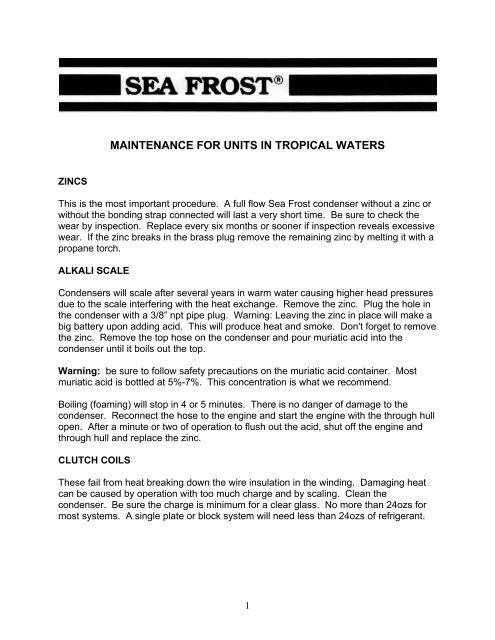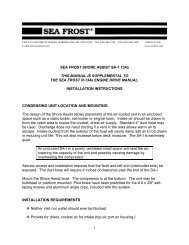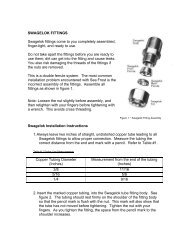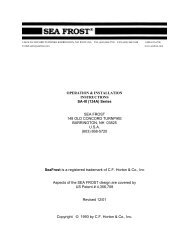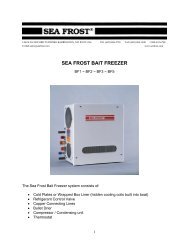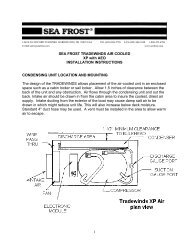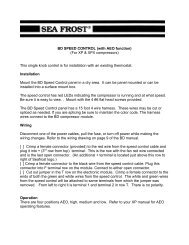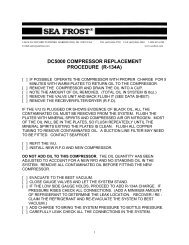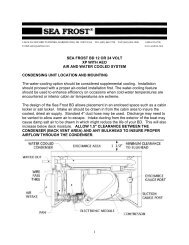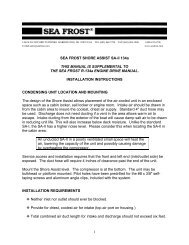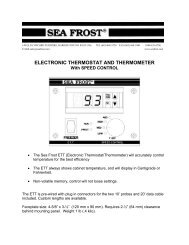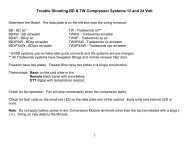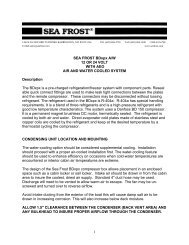Tropical Maintenance - Sea Frost Refrigeration
Tropical Maintenance - Sea Frost Refrigeration
Tropical Maintenance - Sea Frost Refrigeration
You also want an ePaper? Increase the reach of your titles
YUMPU automatically turns print PDFs into web optimized ePapers that Google loves.
MAINTENANCE FOR UNITS IN TROPICAL WATERSZINCSThis is the most important procedure. A full flow <strong>Sea</strong> <strong>Frost</strong> condenser without a zinc orwithout the bonding strap connected will last a very short time. Be sure to check thewear by inspection. Replace every six months or sooner if inspection reveals excessivewear. If the zinc breaks in the brass plug remove the remaining zinc by melting it with apropane torch.ALKALI SCALECondensers will scale after several years in warm water causing higher head pressuresdue to the scale interfering with the heat exchange. Remove the zinc. Plug the hole inthe condenser with a 3/8” npt pipe plug. Warning: Leaving the zinc in place will make abig battery upon adding acid. This will produce heat and smoke. Don't forget to removethe zinc. Remove the top hose on the condenser and pour muriatic acid into thecondenser until it boils out the top.Warning: be sure to follow safety precautions on the muriatic acid container. Mostmuriatic acid is bottled at 5%-7%. This concentration is what we recommend.Boiling (foaming) will stop in 4 or 5 minutes. There is no danger of damage to thecondenser. Reconnect the hose to the engine and start the engine with the through hullopen. After a minute or two of operation to flush out the acid, shut off the engine andthrough hull and replace the zinc.CLUTCH COILSThese fail from heat breaking down the wire insulation in the winding. Damaging heatcan be caused by operation with too much charge and by scaling. Clean thecondenser. Be sure the charge is minimum for a clear glass. No more than 24ozs formost systems. A single plate or block system will need less than 24ozs of refrigerant.1
MAINTENANCELike your engine, your SEA FROST needs periodic checking.ROUTINELY CHECK:1. The refrigerant charge. (Checking the Refrigerant Charge) NEVER OPERATESYSTEM WITHOUT PROPER CHARGE!2. Check belt tension and condition3. Periodically tighten compressor mounting bracket bolts.4. Check the condenser zinc. FAILURE TO MAINTAIN THE ZINC ANODE WILLCAUSE EXTENSIVE DAMAGE TO THE SYSTEM!5. Check all components, bilge and engine room fittings for corrosion and wear. BESURE TO LOCATE AND INSPECT ALL FITTINGS AND COMPONENTS INTHE SYSTEM. KNOW THE LOCATION OF ALL CONNECTION POINTS.Spray with a rust inhibitor REGULARLY. Corrosion unchecked in the marineenvironment will severely reduce the life of your system.6. Winter storage will require that the water-cooled condenser be drained or flushedand filled with antifreeze solution to avoid freeze damage. If the condenser is tobe left dry flushing with a large amount of fresh water to remove salt deposits isrecommended.7. For tropical lay up, flush fresh water through the condenser.CLEANINGThe plate surface protects itself with a layer of oxidation. You might find after a longperiod of storage the plate will look chalky. This will not effect operation and is easilycleaned up with a pot scrubber and soap.2
DETAIL OF CONDENSER ZINC ASSEMBLYTo change the zinc, first close the engine seacock.Using a 7/16” and 11/16” open-end wrenches, holdthe brass plug and remove the outer nut. Carefullybend the ground strap away from the plug. Removethe plug. Water will drain from the condenser or drainthe condenser by removing a hose down stream.Compare the old zinc to a new zinc. Using pliers holdthe zinc and unscrew the plug. If the zinc breaks inthe brass plug, heat the plug holder with a propanetorch to melt the remaining zinc. Thread the new zincinto the plug. Snug with pliers making sure that thezinc is not cracked or stressed by over tightening.Use a pipe thread sealant on the plug thread. BEAWARE THAT THIS IS A TAPERED PIPE THREAD.Thread the plug into the condenser housing about 3/4of the length of the plug. This should seal theconnection. EXCESSIVE TIGHTENING WILLCRACK THE CONDENSER HOUSING. Open theseacock and check for leaks. Reassemble theground strap, and nut. NOTE: This is an electricalconnection; the brass plug and the ground strapshould be free of corrosion and oxidation. The finalassembly should be sprayed corrosion block, T-9, orsimilar rust inhibitor.3


